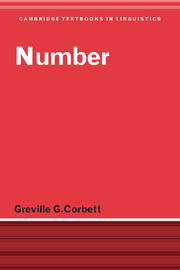Book contents
- Frontmatter
- Contents
- List of figures
- List of tables
- Preface
- List of abbreviations
- 1 Introduction
- 2 Meaning distinctions
- 3 Items involved in the nominal number system
- 4 Integrating number values and the Animacy Hierarchy
- 5 The expression of number
- 6 The syntax of number
- 7 Other uses of number
- 8 Verbal number
- 9 Conclusion and new challenges
- References
- Author index
- Language index
- Subject index
2 - Meaning distinctions
Published online by Cambridge University Press: 05 June 2012
- Frontmatter
- Contents
- List of figures
- List of tables
- Preface
- List of abbreviations
- 1 Introduction
- 2 Meaning distinctions
- 3 Items involved in the nominal number system
- 4 Integrating number values and the Animacy Hierarchy
- 5 The expression of number
- 6 The syntax of number
- 7 Other uses of number
- 8 Verbal number
- 9 Conclusion and new challenges
- References
- Author index
- Language index
- Subject index
Summary
In this chapter we concentrate on the possible meaning distinctions in number systems. Often the situation in languages like English is taken as normal, whereas it represents only one of the possibilities. We will first consider whether number needs to be expressed; we shall see that for some languages the expression of number is in a sense optional, while in others it is a category which speakers cannot avoid. To investigate these systems we shall first consider the notion of ‘general’ number as a meaning distinction and base a partial typology upon it (§2.1). We then narrow our attention to the cases where number is expressed, and establish the main types of distinction within the category (§2.2). Thus §2.1 is devoted to the opposition of number and ‘non-number’, while §2.2 examines the possibilities within the number domain. In §2.3 we propose a typology, systematizing the material examined so far, and we go on to show that languages may simply not have a number system (§2.4); then we consider approaches to number within formal semantics (§2.5).
Our aim in this chapter is to find all the possible distinctions. At this stage we shall not be concerned about the type of nominal we look at, so long as we find those which show the greatest differentiation. Keeping any particular nominal ‘still’ as it were, we shall see how many different numbers it may have available, in the most favourable contexts.
- Type
- Chapter
- Information
- Number , pp. 9 - 53Publisher: Cambridge University PressPrint publication year: 2000



